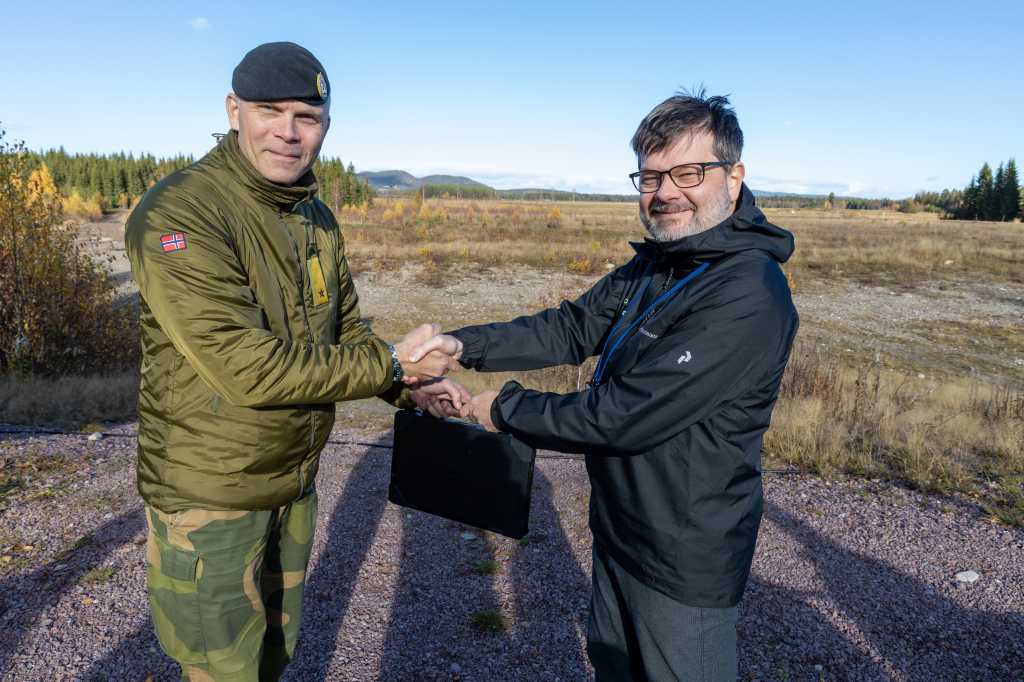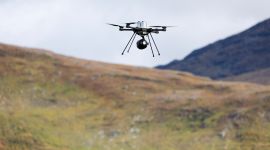The Army has received its first swarm drones
In october, the first swarm drones from SIX Robotics and FFI were delivered to the Norwegian Army.

‘This has been a fruitful joint effort over the past few years,’ said a pleased Brigadier General Trond Haande, head of the Norwegian Army Land Warfare Centre (Hærens våpenskole – HVS), upon receiving the drones.
Going forward, the Army will receive additional deliveries of various surveillance drones with swarm functionality from SIX Robotics. These will be tested operationally in the Army’s manoeuvre units and at the Army Land Warfare Centre.
The software controlling the drones is based on research and development at FFI, with the Army actively participating in testing.
Kai Solem, newly appointed specialist manager of unmanned systems in the Army, was present at the handover.
‘The Army’s drone program is a long-term investment and development project. We will purchase small batches of equipment, keep pace with technological advancements, and perhaps even drive them forward in some areas,’ said Solem.
While the Army begins using its first drone swarm, it is also introducing the Skydio X10D – its first system in the multirotor ISR UAS segment at platoon and company level.
Solem is eager to test the drone swarm:
‘Swarming, with its greater degree of autonomy, will be a major force multiplier, regardless of operational domain. It will free up personnel capacity. The myth about unmanned systems today is that they don’t require much personnel. They do. We see this in Ukraine as well – every drone is flown by a dedicated operator. With swarm technology, we get more eyes and more effectors per operator,’ said Solem.

Future advancements
Dr. Jan Dyre Bjerknes, CTO of SIX Robotics, emphasises that this is a development contract.
‘The swarm we’re delivering now is a product in continuous development. We’ll continue to improve it, add features, and update the software based on feedback from the Army,’ said Bjerknes.
He believes this is the right way to develop military equipment today:
‘The days when the Armed Forces ordered something and then waited ten years for delivery based on outdated specifications are over. If you're not close to the operators who will use the product, you risk building the wrong thing,’ said Bjerknes.
He has a clear vision for how such a swarm can be used:
‘Imagine a large area with hostile activity. You can launch a swarm and ask it to find all enemy targets in that area. Then it’s up to the operator to make decisions and act based on that information. The operator decides what should happen. The drones’ software determines how it should happen.’

Adopted by the Armed Forces
The handover took place during LandX, an annual technology experiment organised by FFI at ICE worx Rena. Here, various research communities work intensively for two weeks on new land domain technologies, in collaboration with industry and the Army.
‘LandX is a good example of how we want to work in the drone program. Here, users, developers, researchers, and industry engineers come together to solve a problem,’ said Solem.
‘It’s about breaking down large, complex problems into smaller, manageable challenges. Then, we work step by step toward a new capability – just like we’ve done with this swarm.’
This year’s LandX included further work on drone swarms, sensor networks, and unmanned vehicles with weapon stations, exploring how they can be used together in various scenarios.
‘This is the sixth time we’re organising LandX. This year, industry participation is stronger than usual,’ said Christian Brunsvig, head of ICE worx at FFI.
‘We see that the technology we’ve worked on for years at LandX is becoming increasingly mature and ready for industrialisation and adoption by the Armed Forces. It’s not just the swarm but also Fjernsyn (‘farsight’ ), a remotely operated sensor system acquired by the Armed Forces. That suggests we’re doing something right,’ said Brunsvig.
Commercialisation of Norwegian technology
The first version of FFI’s Valkyrie swarm flew as early as 2020. In 2024, it was tested by operational personnel during a winter exercise in Finnmark. SIX Robotics has a licensing agreement with FFI to further develop the technology into a commercial solution for military use. The same software is intended to work across many different types of drones.
SIX Robotics has grown rapidly over the past year. They expect to reach 50 employees by the end of the year, and 200 within 1–2 years.


